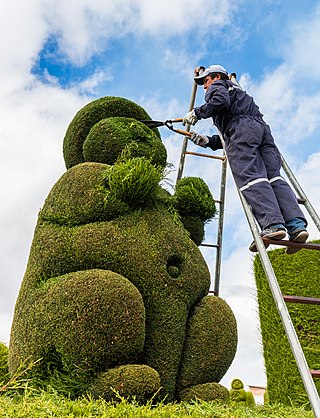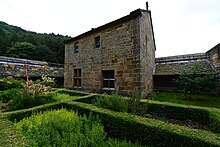
Gardening is the practice of growing and cultivating plants as part of horticulture. In gardens, ornamental plants are often grown for their flowers, foliage, or overall appearance; useful plants, such as root vegetables, leaf vegetables, fruits, and herbs, are grown for consumption, for use as dyes, or for medicinal or cosmetic use.

Hildegard of Bingen, also known as Saint Hildegard and the Sibyl of the Rhine, was a German Benedictine abbess and polymath active as a writer, composer, philosopher, mystic, visionary, and as a medical writer and practitioner during the High Middle Ages. She is one of the best-known composers of sacred monophony, as well as the most recorded in modern history. She has been considered by scholars to be the founder of scientific natural history in Germany.

The early history of gardening is largely entangled with the history of agriculture, with gardens that were mainly ornamental generally the preserve of the elite until quite recent times. Smaller gardens generally had being a kitchen garden as their first priority, as is still often the case.

The doctrine of signatures, dating from the time of Dioscorides and Galen, states that herbs resembling various parts of the body can be used by herbalists to treat ailments of those body parts. A theological justification, as stated by botanists such as William Coles, was that God would have wanted to show men what plants would be useful for.

Medieval medicine in Western Europe was composed of a mixture of pseudoscientific ideas from antiquity. In the Early Middle Ages, following the fall of the Western Roman Empire, standard medical knowledge was based chiefly upon surviving Greek and Roman texts, preserved in monasteries and elsewhere. Medieval medicine is widely misunderstood, thought of as a uniform attitude composed of placing hopes in the church and God to heal all sicknesses, while sickness itself exists as a product of destiny, sin, and astral influences as physical causes. On the other hand, medieval medicine, especially in the second half of the medieval period, became a formal body of theoretical knowledge and was institutionalized in the universities. Medieval medicine attributed illnesses, and disease, not to sinful behaviour, but to natural causes, and sin was connected to illness only in a more general sense of the view that disease manifested in humanity as a result of its fallen state from God. Medieval medicine also recognized that illnesses spread from person to person, that certain lifestyles may cause ill health, and some people have a greater predisposition towards bad health than others.

A herbal is a book containing the names and descriptions of plants, usually with information on their medicinal, tonic, culinary, toxic, hallucinatory, aromatic, or magical powers, and the legends associated with them. A herbal may also classify the plants it describes, may give recipes for herbal extracts, tinctures, or potions, and sometimes include mineral and animal medicaments in addition to those obtained from plants. Herbals were often illustrated to assist plant identification.

Apothecary is an archaic English term for a medical professional who formulates and dispenses materia medica (medicine) to physicians, surgeons, and patients. The modern terms 'pharmacist' and 'chemist' have taken over this role.
Viriditas is a word meaning vitality, fecundity, lushness, verdure, or growth. It is particularly associated with abbess Hildegard von Bingen, who used it to refer to or symbolize spiritual and physical health, often as a reflection of the Divine Word or as an aspect of the divine nature.

An herb farm is usually a farm where herbs are grown for market sale. There is a case for the use of a small farm being dedicated to herb farming as the smaller farm is more efficient in terms of manpower usage and value of the crops on a per acre basis. In addition, the market for herbs is not as large as the more commercial crops, providing the justification for the small-scale herb farm. Herbs may be for culinary, medicinal or aromatic use, and sold fresh-cut or dried. Herbs may also be grown for their essential oils or as raw material for making herbal products. Many businesses calling themselves an herb farm sell potted herb plants for home gardens. Some herb farms also have gift shops, classes, and sometimes offer food for sale. In the United States, some herb farms belong to trade associations.
Ordo Virtutum is an allegorical morality play, or sacred music drama, by Hildegard of Bingen, composed c. 1151, during the construction and relocation of her Abbey at Rupertsberg. It is the earliest morality play by more than a century, and the only medieval musical drama to survive with an attribution for both text and music.

Alain Touwaide is a US historian of medicine and sciences of Belgian origin. He taught history of Greek medicine and its tradition, Food history and other topics in the Medical Humanities at the University of California Los Angeles (UCLA), during the academic years 2015-2016, 2016-2017, 2017-2018, 2018-2019.

A physic garden is a type of herb garden with medicinal plants. Botanical gardens developed from them.

In general use, herbs are a widely distributed and widespread group of plants, excluding vegetables and other plants consumed for macronutrients, with savory or aromatic properties that are used for flavoring and garnishing food, for medicinal purposes, or for fragrances. Culinary use typically distinguishes herbs from spices. Herbs generally refers to the leafy green or flowering parts of a plant, while spices are usually dried and produced from other parts of the plant, including seeds, bark, roots and fruits.
Peter Dendle is a professor of English at Penn State Mont Alto, teaching classes on folklore, 20th and 21st century representations of the Middle Ages, Old and Middle English, and the monstrous. Dendle has written books and articles on a number of topics, including cryptozoology, philology, the demonic in literature, zombie movies, and Medieval plants and medicine. His work on zombies was featured by NPR.
Monastic schools were, along with cathedral schools, the most important institutions of higher learning in the Latin West from the early Middle Ages until the 12th century. Since Cassiodorus's educational program, the standard curriculum incorporated religious studies, the Trivium, and the Quadrivium. In some places monastic schools evolved into medieval universities which eventually largely superseded both institutions as centers of higher learning.

The Tractatus de Herbis is an illustrated treatise of medicinal plants painted in 1440. It is housed under shelfmark Sloane MS 4016 in the British Library, in London.
The history of herbalism is closely tied with the history of medicine from prehistoric times up until the development of the germ theory of disease in the 19th century. Modern medicine from the 19th century to today has been based on evidence gathered using the scientific method. Evidence-based use of pharmaceutical drugs, often derived from medicinal plants, has largely replaced herbal treatments in modern health care. However, many people continue to employ various forms of traditional or alternative medicine. These systems often have a significant herbal component. The history of herbalism also overlaps with food history, as many of the herbs and spices historically used by humans to season food yield useful medicinal compounds, and use of spices with antimicrobial activity in cooking is part of an ancient response to the threat of food-borne pathogens.

Jīvaka was the personal physician of the Buddha and the Indian King Bimbisāra. He lived in Rājagṛha, present-day Rajgir, in the 5th century BCE. Sometimes described as the "Medicine King", he figures prominently in legendary accounts in Asia as a model healer, and is honoured as such by traditional healers in several Asian countries.

Gardening in Scotland, the design of planned spaces set aside for the display, cultivation, and enjoyment of plants and other forms of nature in Scotland began in the Middle Ages.
The Durham Plant-Name Glossary is a glossary translating Latin and Greek plant-names into Old English/Middle English. It was copied in Durham in the early twelfth century. Its principal sources were Greek-Latin-Old English plant-name glossary whose lemmata come from Dioscorides’s De materia medica, which also contributed lemmata and glosses to the Épinal-Erfurt glossaries, and those entries in the Old English Herbarium which translate Latin plant-names with vernacular plant-names. A text very like the Durham Plant-Name Glossary was one major source of the more extensive Laud Herbal Glossary.
















